Performance of Repaired Concrete under Cyclic Flexural Loading
Abstract
:1. Introduction
2. Materials and Methods
2.1. Specimens
2.1.1. Prisms
2.1.2. Cylinders
2.2. Flexural Strength & Cyclic Loading Test
2.3. Non-Destructive Test (NDT) Method
2.4. Bond Test Methods
3. Results and Discussions
3.1. Bond Strength
3.2. Hysteretic Force-Displacement Response
3.3. Loss in after Cyclic Loading
3.4. S-N Curve of Repaired Beams
4. Discussion of Results and Recommendations
5. Conclusions
- Mix M (cementitious repair mortar) showed superior bond performance compared with different repair mixes currently used in the field. Mix M had an average shear bond strength of 12.3 MPa and 16.7 MPa and tensile bond strength of 1.4 MPa and 2.3 MPa at 14 and 28 days of curing, respectively. This study confirmed the benefit of using high-strength materials as repair to improve the bond strength.
- The feasibility of using the Palmgren-Miner rule and Goodman linear model [53] to estimate the fatigue life of repaired structure was confirmed within the context of this study. Mix M, which was estimated to have the highest 2-million-cycle fatigue endurance limit (77.4%), showed the longest fatigue life (95,991 cycles) during cyclic loading test, the highest slant, and splitting bond strength among all repair mixes. Future research may be required to further validate this conclusion by loading the specimen under a fixed cyclic loading range and determining its fatigue life.
- This study found the usefulness of using cycle groups of increasing cyclic stress amplitude to accelerate the fatigue test process. The two-million cycle fatigue endurance limit estimated using cycle groups of Mix S (70.8%) was very similar to what was reported in the literature (71%) using the traditional cyclic loading method. The use of this method will help shorten the time for performing fatigue tests.
- The substrate–repair interface was found to have an important role in determining the static and cyclic flexural performance of the repaired structure. Mix S (control mix) showed twice the flexural strength of repaired samples, better energy absorption capability (higher permanent deformation), and the least drop in (2.3%) after cyclic load. The difference is mainly due to the cold-jointed concrete-repair interface which is the weakest part of the specimens during static and cyclic loading.
- The predicted S-N curve was in line with bond strength, failure pattern, and modulus of elasticity measurements. Specimens repaired with Mix F (cementitious repair concrete), which had a steeper slope compared to other mixes, had the highest drop in elastic modulus (5.2%) and lowest shear and tensile bond strength.
- The limitation of the Palmgren-Miner rule is that it assumes that the specimen will fail when the damage accumulation reaches 100%, which is contrary to the observations from past literature [78,82,83]. Future research may require the involvement of statistical distribution to account for this phenomenon for improved prediction accuracy.
Author Contributions
Funding
Institutional Review Board Statement
Informed Consent Statement
Data Availability Statement
Acknowledgments
Conflicts of Interest
References
- Nobili, A.; Lanzoni, L.; Tarantino, A. Experimental investigation and monitoring of a polypropylene-based fiber reinforced concrete road pavement. Constr. Build. Mater. 2013, 47, 888–895. [Google Scholar] [CrossRef] [Green Version]
- Wang, K.; Jansen, D.C.; Shah, S.P.; Karr, A.F. Permeability study of cracked concrete. Cem. Concr. Res. 1997, 27, 381–393. [Google Scholar] [CrossRef] [Green Version]
- Bissonnette, B.; Courard, D.; Fowler, D.W.; Granju, J.-L. (Eds.) Bonded Cement-Based Material Overlays for the Repair, the Lining or the Strengthening of Slabs or Pavements: State-of-the-Art Report of the RILEM Technical Committee 193-RLS; Springer: Dordrecht, The Netherlands, 2011. [Google Scholar]
- Harries, K.A. ASCE 41 Seismic Assessment of FRP-Repaired Concrete Columns. J. Compos. Constr. 2021, 25, 4021001. [Google Scholar] [CrossRef]
- Guo, T.; Xie, Y.; Weng, X. Evaluation of the bond strength of a novel concrete for rapid patch repair of pavements. Constr. Build. Mater. 2018, 186, 790–800. [Google Scholar] [CrossRef]
- Al-Zahrani, M.; Maslehuddin, M.; Al-Dulaijan, S.; Ibrahim, M. Mechanical properties and durability characteristics of polymer- and cement-based repair materials. Cem. Concr. Compos. 2003, 25, 527–537. [Google Scholar] [CrossRef]
- Vaysburd, A.; Emmons, P. How to make today’s repairs durable for tomorrow-corrosion protection in concrete repair. Constr. Build. Mater. 2000, 14, 189–197. [Google Scholar] [CrossRef]
- Morgan, D. Compatibility of concrete repair materials and systems. Constr. Build. Mater. 1996, 10, 57–67. [Google Scholar] [CrossRef]
- Yang, Z.; Shi, X.; Creighton, A.T.; Peterson, M.M. Effect of styrene–butadiene rubber latex on the chloride permeability and microstructure of Portland cement mortar. Constr. Build. Mater. 2009, 23, 2283–2290. [Google Scholar] [CrossRef]
- Assaad, J.J. Development and use of polymer-modified cement for adhesive and repair applications. Constr. Build. Mater. 2018, 163, 139–148. [Google Scholar] [CrossRef]
- Ye, K.; Ji, J. Current, wave, wind and interaction induced dynamic response of a 5 MW spar-type offshore direct-drive wind turbine. Eng. Struct. 2019, 178, 395–409. [Google Scholar] [CrossRef]
- Lee, M.; Barr, B. An overview of the fatigue behaviour of plain and fibre reinforced concrete. Cem. Concr. Compos. 2004, 26, 299–305. [Google Scholar] [CrossRef]
- Mindess, S.; Young, J.F.; Darwin, D. Concrete, 2nd ed.; Prentice Hall: Upper Saddle River, NJ, USA, 2003. [Google Scholar]
- Saito, M. Direct Tensile Fatigue of Concrete by the Use of Friction Grips. ACI J. Proc. 1983, 80, 431–438. [Google Scholar] [CrossRef]
- Kurumatani, M.; Soma, Y.; Terada, K. Simulations of cohesive fracture behavior of reinforced concrete by a fracture-mechanics-based damage model. Eng. Fract. Mech. 2019, 206, 392–407. [Google Scholar] [CrossRef]
- Hillerborg, A.; Modéer, M.; Petersson, P.-E. Analysis of crack formation and crack growth in concrete by means of fracture mechanics and finite elements. Cem. Concr. Res. 1976, 6, 773–781. [Google Scholar] [CrossRef]
- Keerthana, K.; Kishen, J.C. Micromechanics of fracture and failure in concrete under monotonic and fatigue loadings. Mech. Mater. 2020, 148, 103490. [Google Scholar] [CrossRef]
- Mergheim, J.; Kuhl, E.; Steinmann, P. A finite element method for the computational modelling of cohesive cracks. Int. J. Numer. Methods Eng. 2005, 63, 276–289. [Google Scholar] [CrossRef]
- Unger, J.F.; Eckardt, S.; Könke, C. Modelling of cohesive crack growth in concrete structures with the extended finite element method. Comput. Methods Appl. Mech. Eng. 2007, 196, 4087–4100. [Google Scholar] [CrossRef]
- Yadav, I.N.; Thapa, K.B. Fatigue damage model of concrete materials. Theor. Appl. Fract. Mech. 2020, 108, 102578. [Google Scholar] [CrossRef]
- Zhang, B.; Wu, K. Residual fatigue strength and stiffness of ordinary concrete under bending. Cem. Concr. Res. 1997, 27, 115–126. [Google Scholar] [CrossRef]
- Chen, X.; Bu, J.; Fan, X.; Lu, J.; Xu, L. Effect of loading frequency and stress level on low cycle fatigue behavior of plain concrete in direct tension. Constr. Build. Mater. 2017, 133, 367–375. [Google Scholar] [CrossRef]
- Simon, K.M.; Kishen, J.C. A multiscale approach for modeling fatigue crack growth in concrete. Int. J. Fatigue 2017, 98, 1–13. [Google Scholar] [CrossRef]
- Fan, J.; Jiang, D.; Chen, J.; Liu, W.; Ngaha, W.T.; Chen, J. Fatigue performance of ordinary concrete under discontinuous cyclic loading. Constr. Build. Mater. 2018, 166, 974–981. [Google Scholar] [CrossRef]
- McClung, R.; Sehitoglu, H. On the finite element analysis of fatigue crack closure-1. Basic modeling issues. Eng. Fract. Mech. 1989, 33, 237–252. [Google Scholar] [CrossRef]
- Xiao, J.-Q.; Ding, D.-X.; Jiang, F.-L.; Xu, G. Fatigue damage variable and evolution of rock subjected to cyclic loading. Int. J. Rock Mech. Min. Sci. 2010, 47, 461–468. [Google Scholar] [CrossRef]
- Miner, M.A. Cumulative damage in fatigue. J. Appl. Mech. 1945, 12, A159–A164. [Google Scholar] [CrossRef]
- Baktheer, A.; Hegger, J.; Chudoba, R. Enhanced assessment rule for concrete fatigue under compression considering the nonlinear effect of loading sequence. Int. J. Fatigue 2019, 126, 130–142. [Google Scholar] [CrossRef]
- Keerthana, K.; Kishen, J.C. An experimental and analytical study on fatigue damage in concrete under variable amplitude loading. Int. J. Fatigue 2018, 111, 278–288. [Google Scholar] [CrossRef]
- Alliche, A. Damage model for fatigue loading of concrete. Int. J. Fatigue 2004, 26, 915–921. [Google Scholar] [CrossRef]
- El Aghoury, I.; Galal, K. A fatigue stress-life damage accumulation model for variable amplitude fatigue loading based on virtual target life. Eng. Struct. 2013, 52, 621–628. [Google Scholar] [CrossRef]
- Shah, S.G.; Ray, S.; Kishen, J.C. Fatigue crack propagation at concrete–concrete bi-material interfaces. Int. J. Fatigue 2014, 63, 118–126. [Google Scholar] [CrossRef]
- Shah, S.G.; Kishen, J.C. Nonlinear fracture properties of concrete-concrete interfaces. Mech. Mater. 2010, 42, 916–931. [Google Scholar] [CrossRef]
- Shah, S.G.; Kishen, J.C. Fracture behavior of concrete–concrete interface using acoustic emission technique. Eng. Fract. Mech. 2010, 77, 908–924. [Google Scholar] [CrossRef]
- Ong, K.C.G.; Paramasivam, P.; Subramanian, M. Cyclic Behavior of Steel-Fiber Mortar Overlaid Concrete Beams. J. Mater. Civ. Eng. 1997, 9, 21–28. [Google Scholar] [CrossRef]
- Murthy, A.R.; Karihaloo, B.; Rani, P.V.; Priya, D.S. Fatigue behaviour of damaged RC beams strengthened with ultra high performance fibre reinforced concrete. Int. J. Fatigue 2018, 116, 659–668. [Google Scholar] [CrossRef]
- Ganesh, P.; Murthy, A.R. Fatigue performance of damaged RC beams rehabilitated with GGBS based ultra high performance concrete. Int. J. Fatigue 2020, 138, 105707. [Google Scholar] [CrossRef]
- Wang, M.; Wang, R.; Yao, H.; Farhan, S.; Zheng, S.; Wang, Z.; Du, C.; Jiang, H. Research on the mechanism of polymer latex modified cement. Constr. Build. Mater. 2016, 111, 710–718. [Google Scholar] [CrossRef]
- Aggarwal, L.; Thapliyal, P.; Karade, S. Properties of polymer-modified mortars using epoxy and acrylic emulsions. Constr. Build. Mater. 2007, 21, 379–383. [Google Scholar] [CrossRef]
- Ramli, M.; Tabassi, A.A. Effects of polymer modification on the permeability of cement mortars under different curing conditions: A correlational study that includes pore distributions, water absorption and compressive strength. Constr. Build. Mater. 2012, 28, 561–570. [Google Scholar] [CrossRef]
- Wu, B.; Tang, Y.; Li, Z.; Tang, K. Fatigue damage accumulation modelling of critical components subjected to moving crane loads in reinforced-concrete industrial buildings. Eng. Fail. Anal. 2021, 119, 104951. [Google Scholar] [CrossRef]
- Wang, B.; Gupta, R. Analyzing bond-deterioration during freeze-thaw exposure in cement-based repairs using non-destructive methods. Cem. Concr. Compos. 2021, 115, 103830. [Google Scholar] [CrossRef]
- ASTM International. C136—Standard Test Method for Sieve Analysis of Fine and Coarse; ASTM International: West Conshohocken, PA, USA, 2019. [Google Scholar] [CrossRef]
- ACI Committee 211. Standard Practice for Selecting Proportions for Normal, Heavyweight, and Mass Concrete:(ACI 211.1-91); American Concrete Institute: Farmington Hills, MI, USA, 1991. [Google Scholar]
- ASTM International. C09 Committee Test Method for Air Content of Freshly Mixed Concrete by the Pressure Method; ASTM International: West Conshohocken, PA, USA, 2017. [Google Scholar] [CrossRef]
- ASTM International. C09 Committee Test Method for Slump of Hydraulic-Cement Concrete; ASTM International: West Conshohocken, PA, USA, 2016. [Google Scholar] [CrossRef]
- ASTM International. C09 Committee Test Method for Compressive Strength of Cylindrical Concrete Specimens; ASTM International: West Conshohocken, PA, USA, 2018. [Google Scholar] [CrossRef]
- Wang, R.; Gupta, B.; Dias, P.; Bergen, T. Coefficient of permeability of cement-based repair materials. In Proceedings of the 1st International Conference on New Horizons in Civil Engineering, Victoria, BC, Canada, 25–27 April 2018. [Google Scholar]
- Wang, B.; Gupta, R. Correlation of Electrical Conductivity, Compressive Strength, and Permeability of Repair Materials. ACI Mater. J. 2020, 117, 53–63. [Google Scholar] [CrossRef]
- Bajaj, R.; Wang, B.; Gupta, R. Characterization of Enhanced ITZ in Engineered Polypropylene Fibers for Bond Improvement. J. Compos. Sci. 2020, 4, 53. [Google Scholar] [CrossRef]
- International Concrete Repair Institute. Guideline No. 310.2R-2013 Selecting and Specifying Concrete Surface Preparation for Sealers, Coatings, Polymer Overlays, and Concrete Repair; International Concrete Repair Institute: St. Paul, MN, USA, 2013. [Google Scholar]
- ASTM International. C09 Committee Test Method for Bond Strength of Epoxy-Resin Systems Used with Concrete by Slant Shear; ASTM International: West Conshohocken, PA, USA, 2014. [Google Scholar] [CrossRef]
- Nieto, A.; Chicharro, J.; Pintado, P. An approximated methodology for fatigue tests and fatigue monitoring of concrete specimens. Int. J. Fatigue 2006, 28, 835–842. [Google Scholar] [CrossRef] [Green Version]
- ASTM International. C09 Committee Test Method for Splitting Tensile Strength of Cylindrical Concrete Specimens; ASTM International: West Conshohocken, PA, USA, 2017. [Google Scholar]
- Figueira, D.; Sousa, C.; Calçada, R.; Neves, A.S. Push-off Tests in the Study of Cyclic Behavior of Interfaces between Concretes Cast at Different Times. J. Struct. Eng. 2016, 142, 4015101. [Google Scholar] [CrossRef]
- Feng, S.; Xiao, H.; Geng, J. Bond strength between concrete substrate and repair mortar: Effect of fibre stiffness and substrate surface roughness. Cem. Concr. Compos. 2020, 114, 103746. [Google Scholar] [CrossRef]
- Zhang, Y.; Zhu, P.; Liao, Z.; Wang, L. Interfacial bond properties between normal strength concrete substrate and ultra-high performance concrete as a repair material. Constr. Build. Mater. 2020, 235, 117431. [Google Scholar] [CrossRef]
- Feng, S.; Xiao, H.; Li, H. Comparative studies of the effect of ultrahigh-performance concrete and normal concrete as repair materials on interfacial bond properties and microstructure. Eng. Struct. 2020, 222, 111122. [Google Scholar] [CrossRef]
- Zanotti, C.; Randl, N. Are concrete-concrete bond tests comparable? Cem. Concr. Compos. 2019, 99, 80–88. [Google Scholar] [CrossRef]
- Peng, G.; Niu, D.; Hu, X.; Pan, B.; Zhong, S. Experimental study of the interfacial bond strength between cementitious grout and normal concrete substrate. Constr. Build. Mater. 2021, 273, 122057. [Google Scholar] [CrossRef]
- Feng, S.; Xiao, H.; Zhang, R.; Yang, C. Bond performance between substrate concrete and repair mortar: Effect of carbon fibre and expansive agent. Constr. Build. Mater. 2020, 250, 118830. [Google Scholar] [CrossRef]
- Rashid, K.; Ahmad, M.; Ueda, T.; Deng, J.; Aslam, K.; Nazir, I.; Sarwar, M.A. Experimental investigation of the bond strength between new to old concrete using different adhesive layers. Constr. Build. Mater. 2020, 249, 118798. [Google Scholar] [CrossRef]
- Zanotti, C.; Banthia, N.; Plizzari, G. A study of some factors affecting bond in cementitious fiber reinforced repairs. Cem. Concr. Res. 2014, 63, 117–126. [Google Scholar] [CrossRef]
- Júlio, E.N.; Branco, F.A.; Silva, V.D. Concrete to concrete bond strength. Influence of the roughness of the substrate surface. Constr. Build. Mater. 2004, 18, 675–681. [Google Scholar] [CrossRef] [Green Version]
- Austin, S.; Robins, P.; Pan, Y. Shear bond testing of concrete repairs. Cem. Concr. Res. 1999, 29, 1067–1076. [Google Scholar] [CrossRef]
- Chen, P.-W.; Fu, X.; Chung, D. Improving the bonding between old and new concrete by adding carbon fibers to the new concrete. Cem. Concr. Res. 1995, 25, 491–496. [Google Scholar] [CrossRef]
- Valikhani, A.; Jahromi, A.J.; Mantawy, I.M.; Azizinamini, A. Experimental evaluation of concrete-to-UHPC bond strength with correlation to surface roughness for repair application. Constr. Build. Mater. 2020, 238, 117753. [Google Scholar] [CrossRef]
- Arezoumandi, M.; Wirkman, C.; Volz, J.S. Performance of Fiber-reinforced Self-consolidating Concrete for Repair of Bridge Substructures. Structures 2018, 15, 320–328. [Google Scholar] [CrossRef]
- Zanotti, C.; Borges, P.H.; Bhutta, A.; Banthia, N. Bond strength between concrete substrate and metakaolin geopolymer repair mortar: Effect of curing regime and PVA fiber reinforcement. Cem. Concr. Compos. 2017, 80, 307–316. [Google Scholar] [CrossRef]
- Göbel, L.; Bos, C.; Schwaiger, R.; Flohr, A.; Osburg, A. Micromechanics-based investigation of the elastic properties of polymer-modified cementitious materials using nanoindentation and semi-analytical modeling. Cem. Concr. Compos. 2018, 88, 100–114. [Google Scholar] [CrossRef]
- Momayez, A.; Ehsani, M.; Ramezanianpour, A.; Rajaie, H. Comparison of methods for evaluating bond strength between concrete substrate and repair materials. Cem. Concr. Res. 2005, 35, 748–757. [Google Scholar] [CrossRef]
- Fadadu, M.; Vadher, N.; Trivedi, V.; Mungule, M.; Iyer, K.K. A comparative study on stress-strain response and associated hysteresis for conventional and PET macro-reinforced concrete. Constr. Build. Mater. 2020, 264, 120534. [Google Scholar] [CrossRef]
- Park, S.-K. Flexural behavior of reinforced concrete beams with cementitious repair materials. Mater. Struct. 2005, 38, 329–334. [Google Scholar] [CrossRef]
- Hui-Cai, X.; Geng-Ying, L.; Guang-Jing, X. Microstructure model of the interfacial zone between fresh and old concrete. J. Wuhan Univ. Technol. Sci. Ed. 2002, 17, 64–68. [Google Scholar] [CrossRef]
- Goel, S.; Singh, S.P.; Singh, P. Flexural fatigue strength and failure probability of Self Compacting Fibre Reinforced Concrete beams. Eng. Struct. 2012, 40, 131–140. [Google Scholar] [CrossRef]
- Singh, S.P.; Kaushik, S.K. Flexural Fatigue Analysis of Steel Fiber-Reinforced Concrete. ACI Mater. J. 2001, 98, 306–312. [Google Scholar] [CrossRef]
- Yeon, K.-S.; Choi, Y.-S.; Kim, K.-K.; Yeon, J.H. Flexural fatigue life analysis of unsaturated polyester-methyl methacrylate polymer concrete. Constr. Build. Mater. 2017, 140, 336–343. [Google Scholar] [CrossRef]
- Goel, S.; Singh, S. Fatigue performance of plain and steel fibre reinforced self compacting concrete using S-N relationship. Eng. Struct. 2014, 74, 65–73. [Google Scholar] [CrossRef]
- Zhang, B.; Phillips, D.V.; Wu, K. Further research on fatigue properties of plain concrete. Mag. Concr. Res. 1997, 49, 241–252. [Google Scholar] [CrossRef]
- Johnston, C.D.; Zemp, R.W. Flexural Fatigue Performance of Steel Fiber Reinforced Concrete—Influence of Fiber Content, Aspect Ratio, and Type. ACI Mater. J. 1991, 88, 374–383. [Google Scholar] [CrossRef]
- Batson, G.; Ball, C.; Bailey, L.; Landers, E.; Hooks, J. Flexural Fatigue Strength of Steel Fiber Reinforced Concrete Beams. ACI J. Proc. 1972, 69, 673–677. [Google Scholar] [CrossRef]
- Arora, S.; Singh, S. Analysis of flexural fatigue failure of concrete made with 100% Coarse Recycled Concrete Aggregates. Constr. Build. Mater. 2016, 102, 782–791. [Google Scholar] [CrossRef]
- Saini, B.S.; Singh, S. Flexural fatigue strength prediction of self compacting concrete made with recycled concrete aggregates and blended cements. Constr. Build. Mater. 2020, 264, 120233. [Google Scholar] [CrossRef]
- ACI Committee 318 and American Concrete Institute (ACI). Building Code Requirements for Structural Concrete (ACI 318-14): An ACI Standard and Commentary on Building Code Requerements for Structural Concrete (ACI 318R-14): An ACI Report; American Concrete Institute: Farmington Hills, MI, USA, 2014. [Google Scholar]
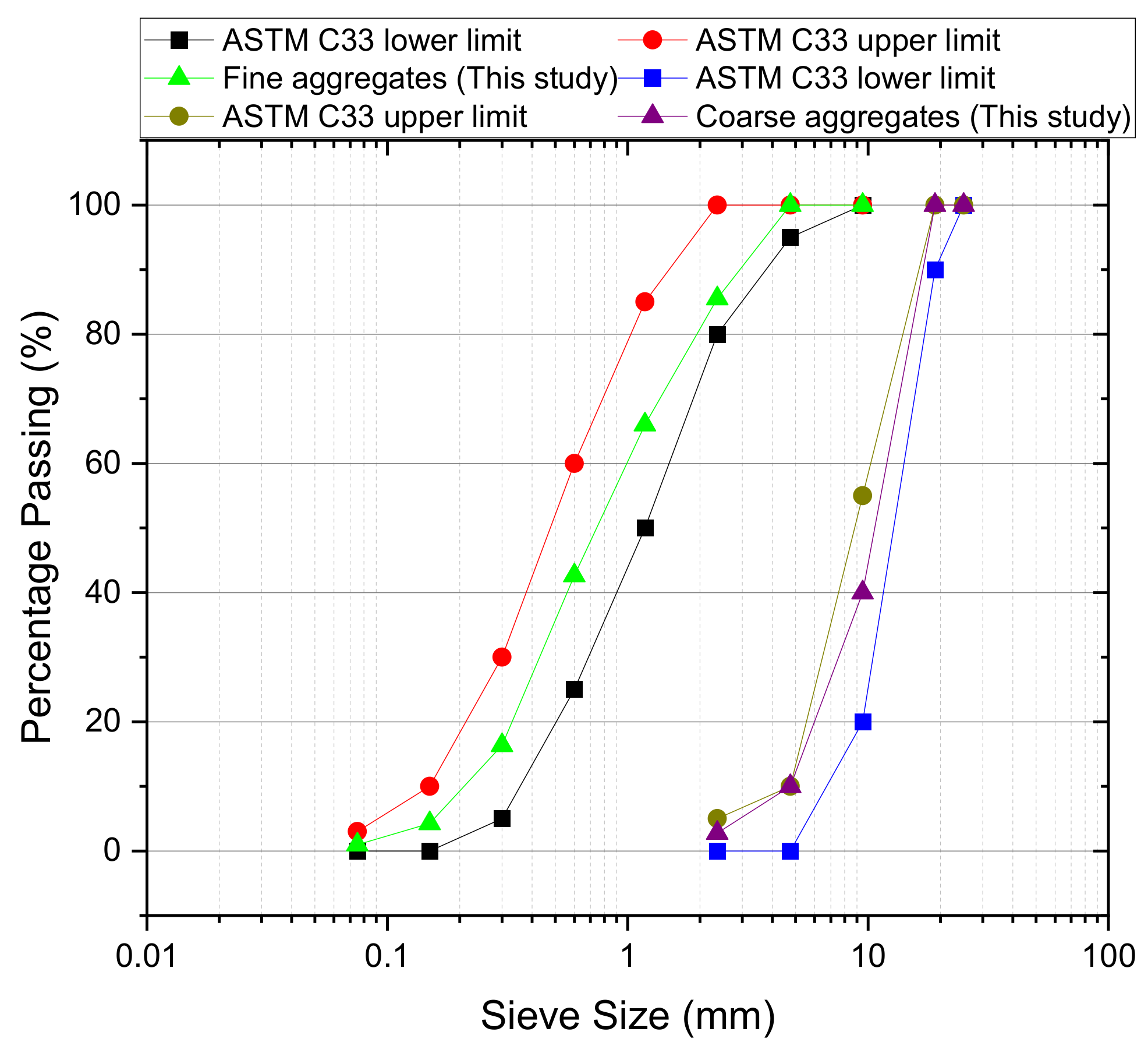

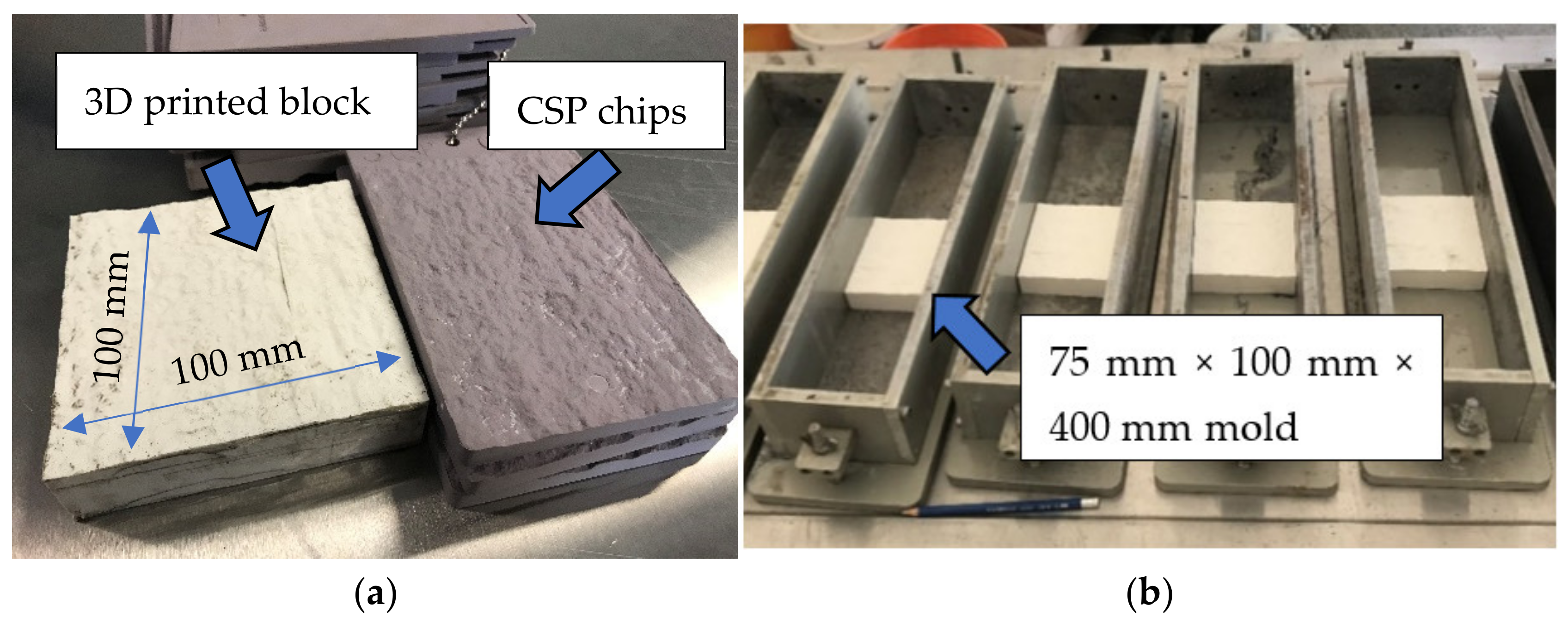

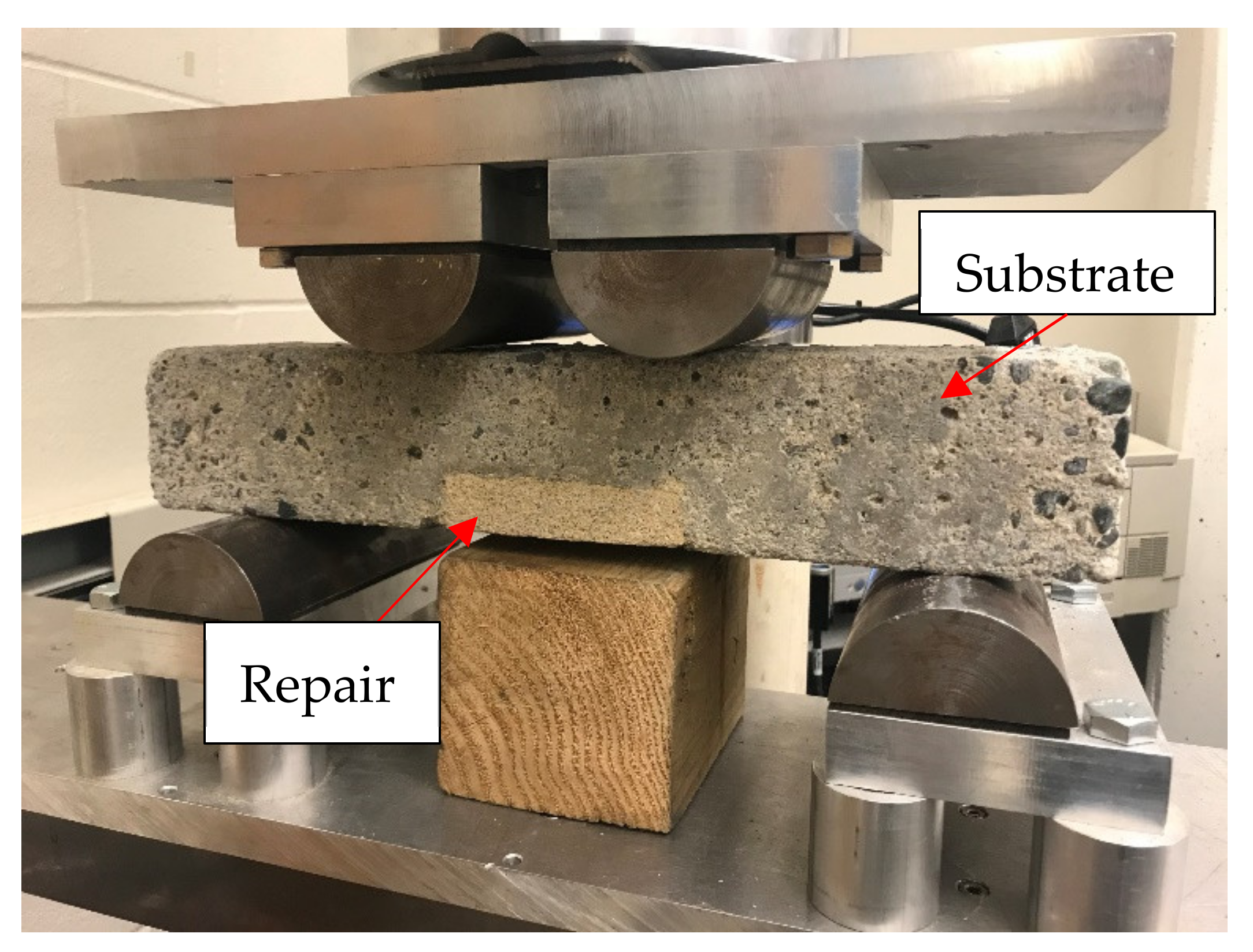

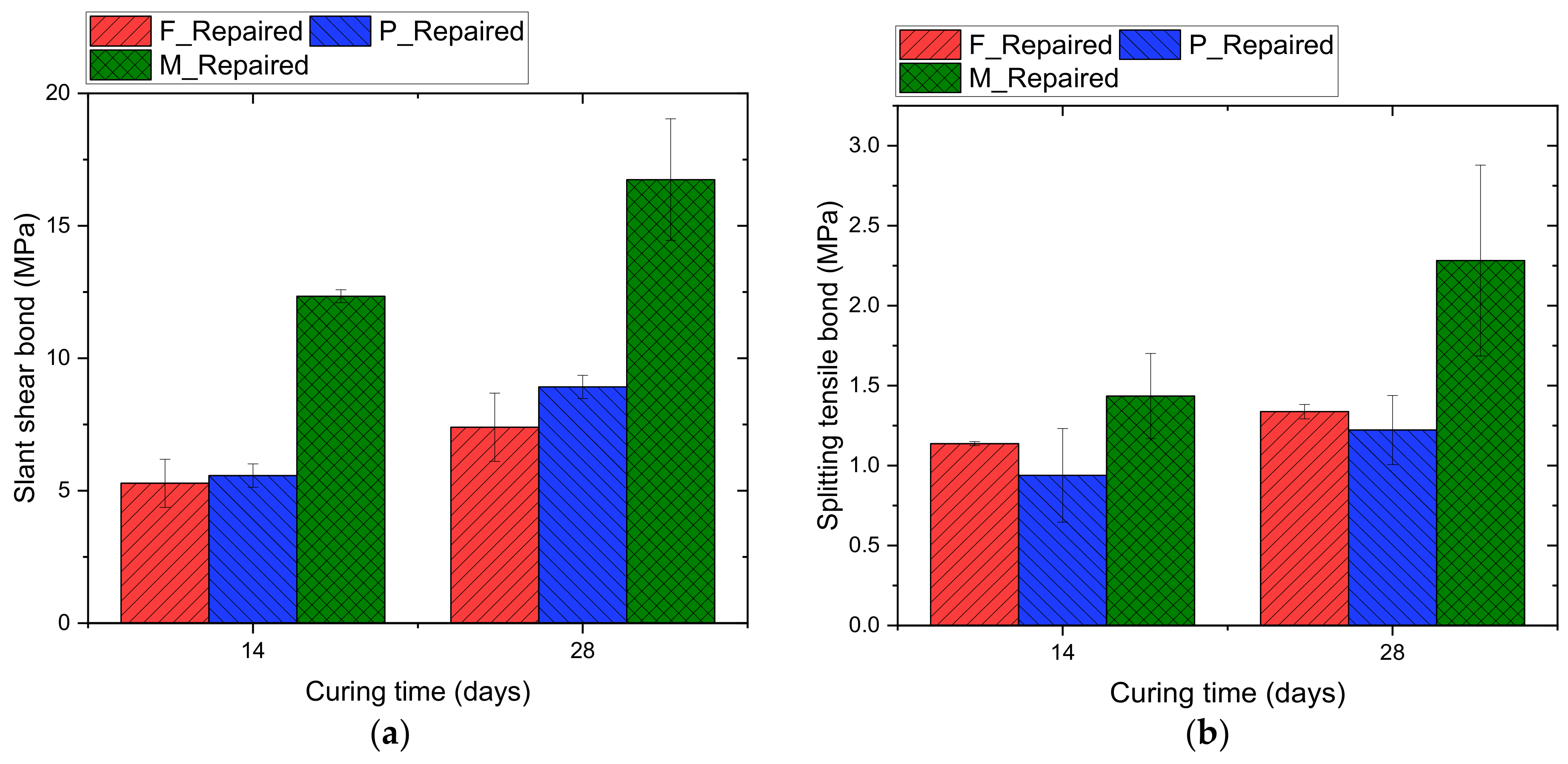
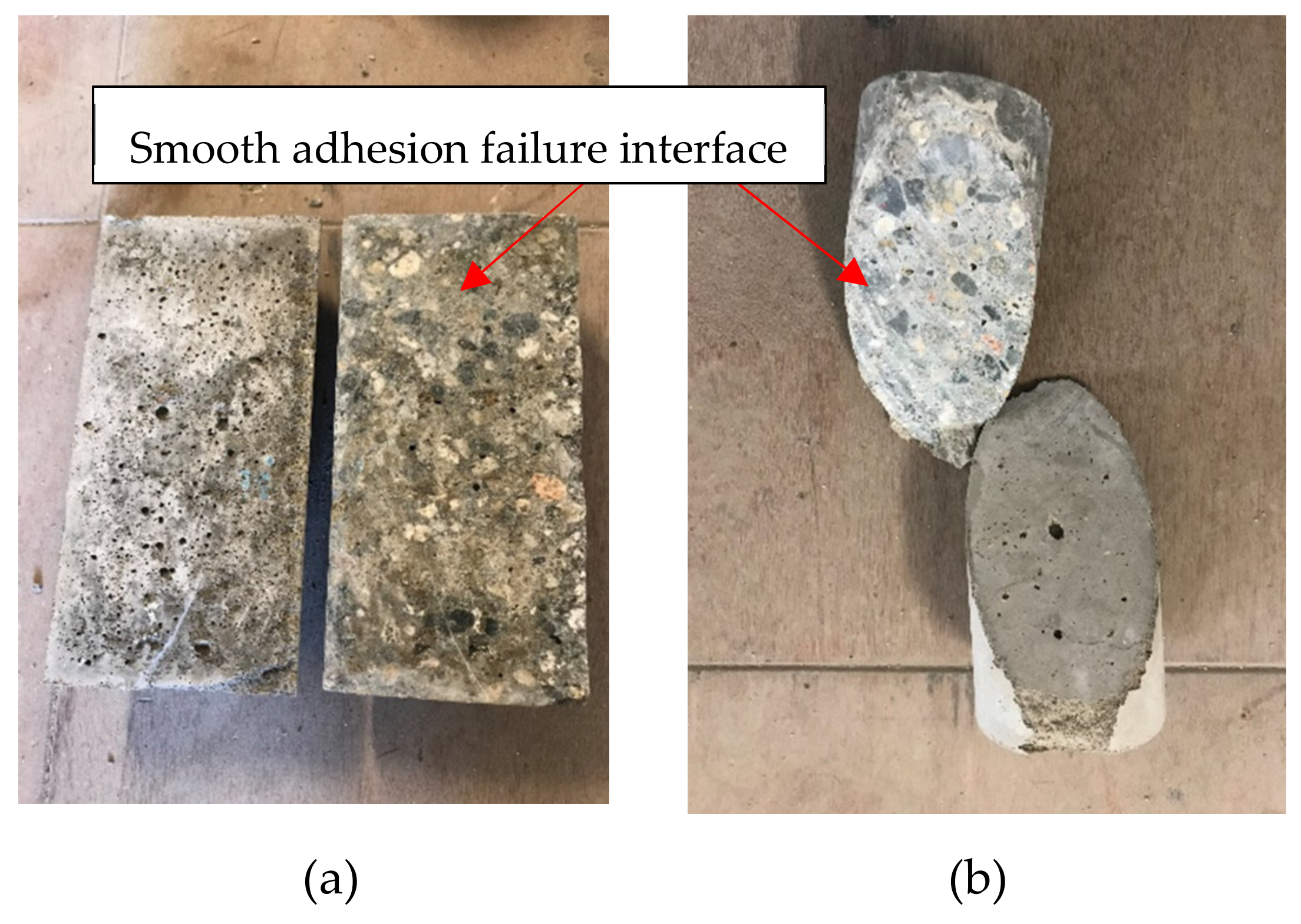
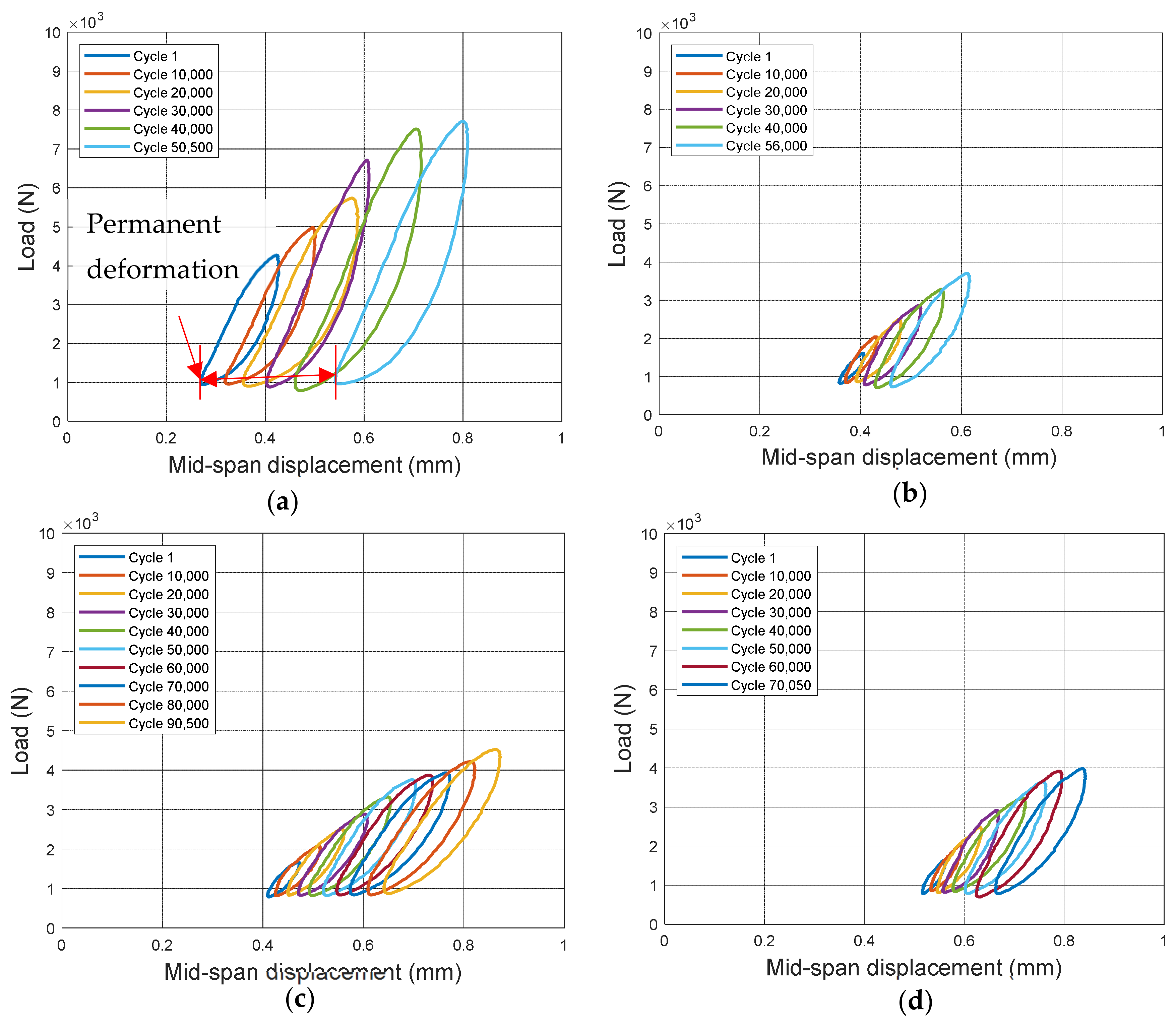
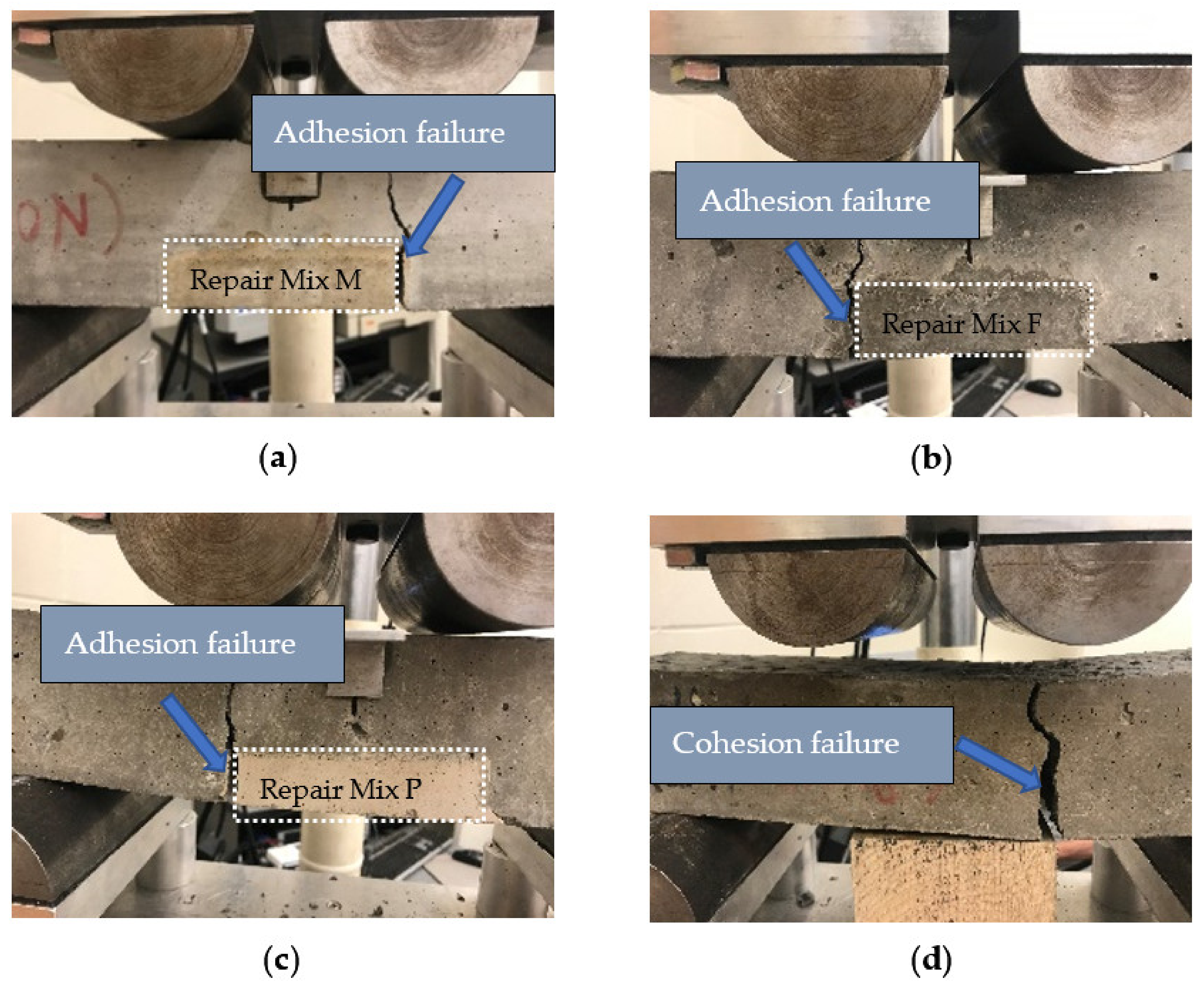
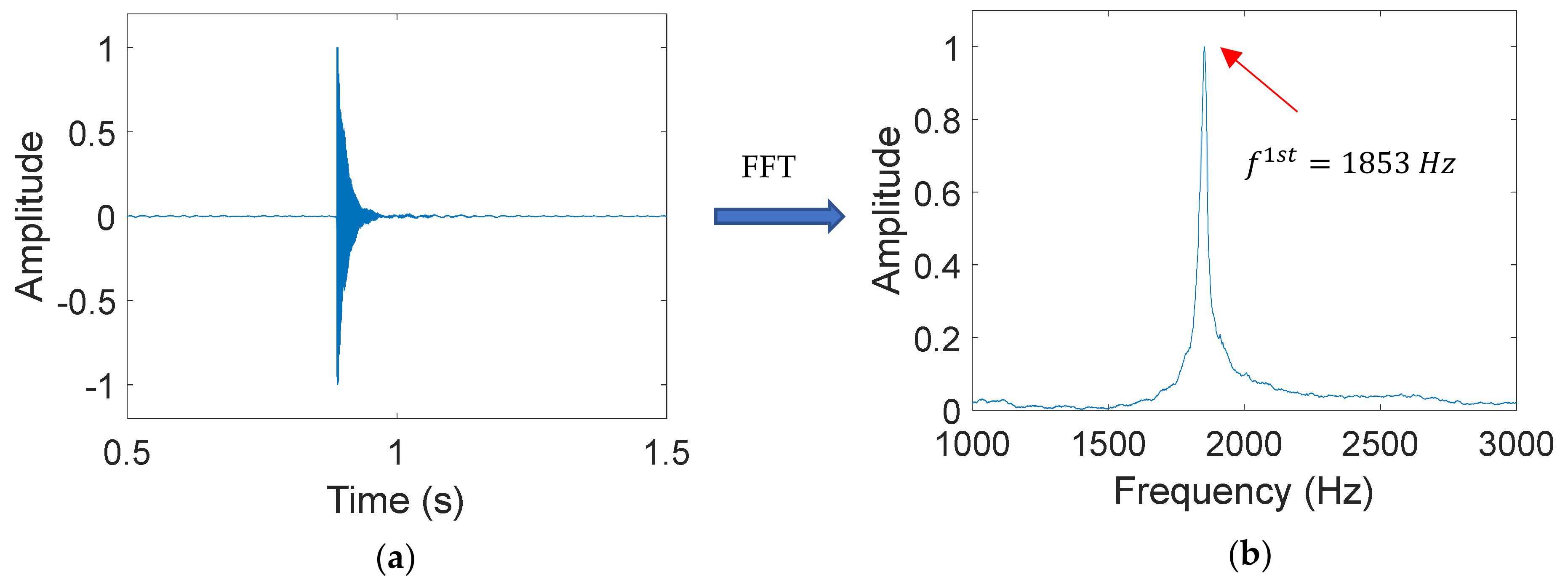

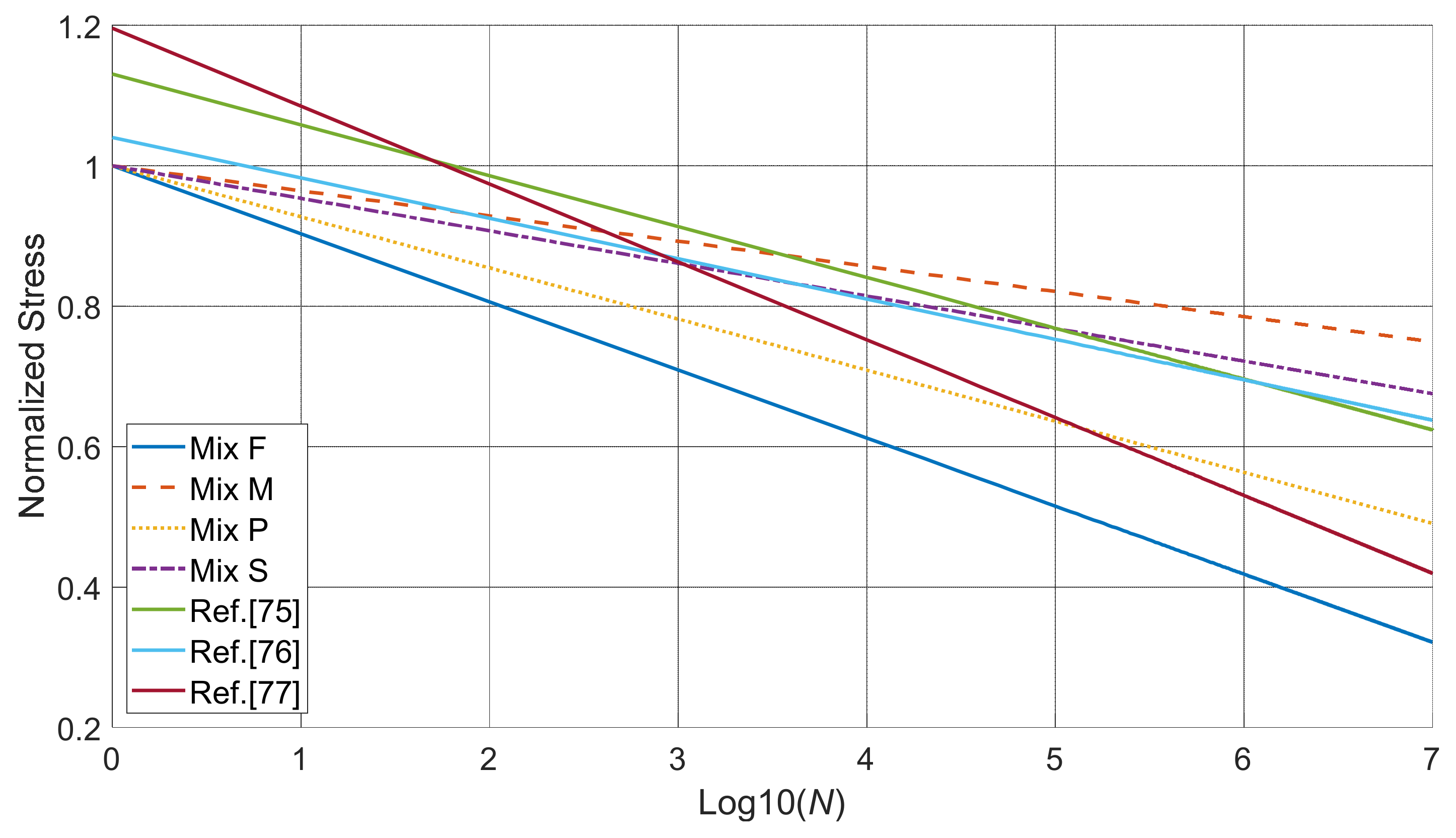
| Name | Fine Aggregate | Coarse Aggregate | Cement | Superplasticizer | Air-Entraining Agent | Water |
|---|---|---|---|---|---|---|
| Mix S | 762 | 1053 | 450 | 2.25 | 2.25 | 153.7 |
| Material Type | Hardened Properties | Fresh Properties | ||||
|---|---|---|---|---|---|---|
| Slump (mm) | Time to Set (min) | w/m | Air Content Percentage (%) | |||
| Repair Mix M | 2325 | 70 | 75 | 0.09 | 5.0 | |
| Repair Mix F | 2374 | 80 | - | 0.1 | 5.1 | |
| Repair Mix P | 2289 | 15 | 9 | 0.18 | 7 | |
| Parent Mix S | 2530 | 60 | 90 | 0.067 | 4.9 | |
| Percent of Ultimate Load (%) | Mix S | Mix F | Mix M | Mix P | ||||
|---|---|---|---|---|---|---|---|---|
| Max. | Min. | Max. | Min. | Max. | Min. | Max. | Min. | |
| 55 | 4235 | 800 | 2090 | 800 | 2090 | 800 | 2090 | 800 |
| 65 | 5005 | 800 | 2470 | 800 | 2470 | 800 | 2470 | 800 |
| 75 | 5775 | 800 | 2850 | 800 | 2850 | 800 | 2850 | 800 |
| 85 | 6545 | 800 | 3230 | 800 | 3230 | 800 | 3230 | 800 |
| 95 | 7315 | 800 | 3610 | 800 | 3610 | 800 | 3610 | 800 |
| 100 | 7700 | 800 | 3800 | 800 | 3800 | 800 | 3800 | 800 |
| Specimen | ||
|---|---|---|
| Mix F-repaired sample | 0.18 | 58,580 |
| Mix M-repaired sample | 0.22 | 95,991 |
| Mix P-repaired sample | 0.11 | 57,530 |
| Mix S | 0.24 | 41,311 |
Publisher’s Note: MDPI stays neutral with regard to jurisdictional claims in published maps and institutional affiliations. |
© 2021 by the authors. Licensee MDPI, Basel, Switzerland. This article is an open access article distributed under the terms and conditions of the Creative Commons Attribution (CC BY) license (http://creativecommons.org/licenses/by/4.0/).
Share and Cite
Wang, B.; Gupta, R. Performance of Repaired Concrete under Cyclic Flexural Loading. Materials 2021, 14, 1363. https://doi.org/10.3390/ma14061363
Wang B, Gupta R. Performance of Repaired Concrete under Cyclic Flexural Loading. Materials. 2021; 14(6):1363. https://doi.org/10.3390/ma14061363
Chicago/Turabian StyleWang, Boyu, and Rishi Gupta. 2021. "Performance of Repaired Concrete under Cyclic Flexural Loading" Materials 14, no. 6: 1363. https://doi.org/10.3390/ma14061363







